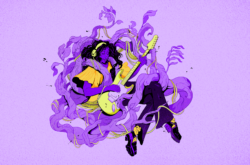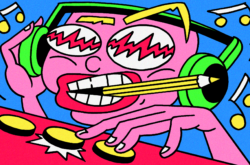Illustration: Franco Égalité
Finding that initial spark of inspiration can sometimes be the hardest part of making music.
Whether it’s an empty DAW session or a blank piece of paper, the mental hurdle of committing the first idea for a song can be paralyzing. In this article, let’s explore six creative songwriting techniques that can get you out of your head and start feeling inspired the next time you’re not sure how to begin.
1. Start with a hummable melody
Your melodies will often be what a listener latches on to—and for this reason, they’re regularly a go-to starting point for songs. However, when trying to write them via MIDI in the DAW, or even on a physical instrument like the piano or guitar, we can sometimes get carried away and end up with melodies that are overly complex or just don’t stick.
An effective technique for arriving to a memorable melody that you can build your song around is leaning into humming. Humming helps ensure that your melodies won’t be inaccessible, and you’ll naturally stick within reasonable melodic ranges and rhythms. It can also help you better connect with how different melodies feel emotionally, and assess whether they flow naturally.
2. Start with a chord progression
The flip side of starting with a melody is starting with a chord progression. Whether it’s major, minor, or modal, this is a great way to establish a concrete but open-ended emotional palette for your song that you can then write melodies or sequence beats over.
If a particular progression doesn’t come to mind, consider analyzing the chords of songs you like. You’re also welcome to draw on any of these free MIDI chord progressions or download our Collection of free songstarters for inspiration. Once you land on a chord progression you want to use, you can loop it in your DAW and try humming ideas over it, add or subtract energy by adjusting the harmonic rhythm, or play with different inversions and extensions to introduce emotional nuances.
3. Start with a one-shot or timbre
If you tend to gravitate towards production and sound design, starting with a one-shot or timbre might feel more natural for you over melodies or chord progressions. If you’re not feeling inspired by your existing collection of sounds, try using resources like sample libraries to discover one-shots and software instruments presets that you haven’t used before.
Alternatively, recording your own one-shots can be another great technique for finding new sounds that inspire your songwriting. There’s no need to solely stick to capturing traditional instruments here—what would happen if you used household objects to design drum sounds, or transformed a dog bark into a sound effect? Let your imagination guide you, and pay attention to the ideas that surface when you venture outside of the box.
4. Start with a source of inspiration
There’s no shame in drawing inspiration from the creativity of others. Diving into the discographies of the musicians and bands you look up to is probably the go-to, and creating production-minded playlists can be a great avenue for this.
That said, if you’re concerned about sounding too similar to your inspirations, consider also thinking about mediums beyond music. Is there a book you read recently that moved you? What are some narrative and emotional themes that arose in your favorite TV show? What would a particular piece of visual art sound like? The other art forms that you enjoy can be subtle but incredibly powerful sources for inspiration.
5. Start with a challenge or limitation
A major reason for why a blank slate is so paralyzing is that it simply presents too many options; because you can take the song anywhere, it’s hard to decide where to go.
If you feel this way, a creative challenge or limitation can be a great tool for sparking ideas. The key is to choose something that provides some amount of structure while still being flexible enough for you to exercise your creative muscles—below, we’ve highlighted 12 challenges that we’ve found success with.
6. Start with a vibe
Last but not least, you can start with a musical or emotional vibe that you can then develop into a more fleshed-out idea. This sounds nebulous on the surface, but can be done very strategically with a tool like Create, which allows you to experiment with billions of combinations of loops that work together within a selected style.
This lets you explore melodies, chord progressions, and timbres all at the same time, and export any sounds you like to your DAW for further iteration. And even if you’re not a Splice subscriber, anyone can build Stacks in Create, which in itself can be a great activity for sparking ideas or building unique backing tracks to sing or riff over.
Creative songwriting techniques: Conclusion
So there you have it! We hope the above songwriting techniques unlock your creativity and inspire you to try something different the next time you’re starting a new song. Regardless of which technique you choose, the best thing to do is to try to explore ideas with an open and playful mindset—after all, music creation should be fun, and you’ll uncover the best ideas when you’re enjoying the process of venturing into new territory rather than concerning yourself with having to make something that’s perfect from the jump.
Are you looking for more tips and tricks on getting inspired? Do you have any songwriting techniques of your own that you’d like to share? Start a conversation with us and a vibrant community of other music creators via the Splice Discord.
Find inspiration with our new sample discovery feature:
June 30, 2023



